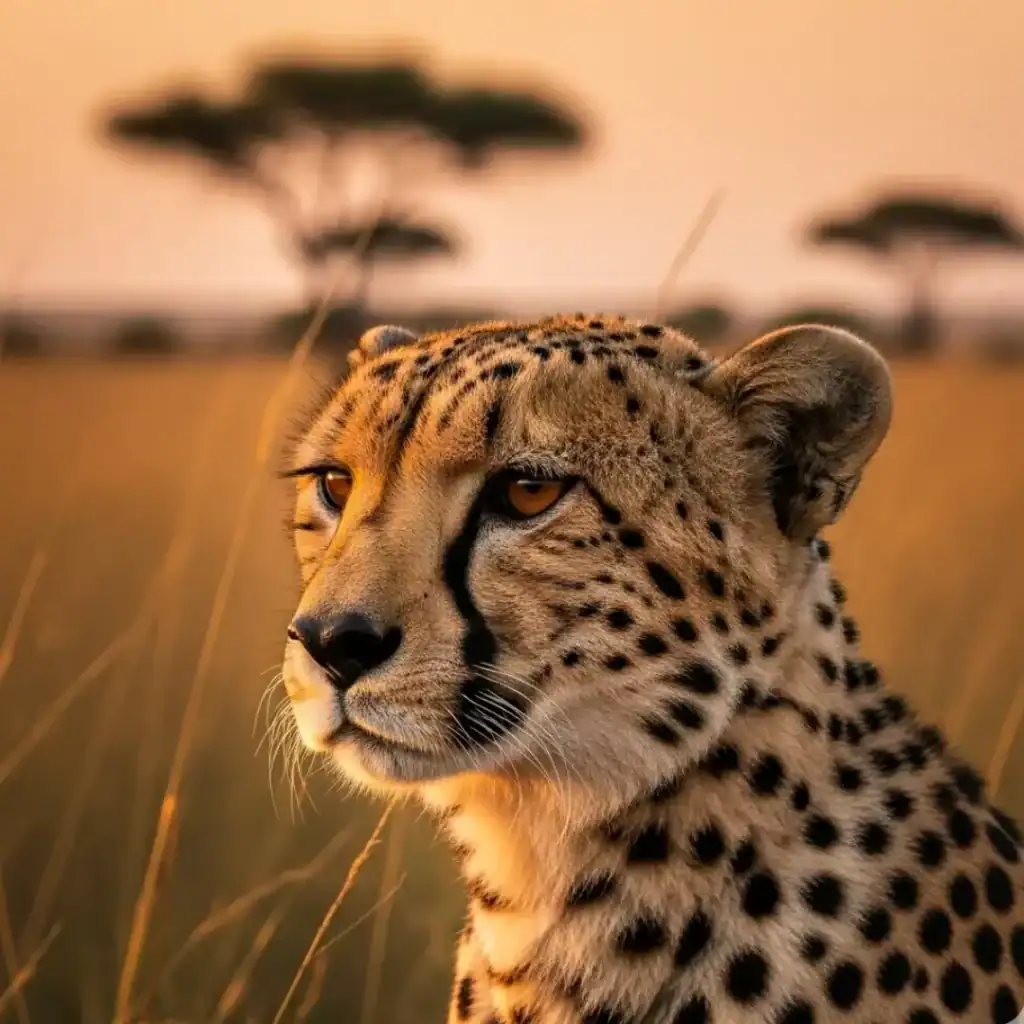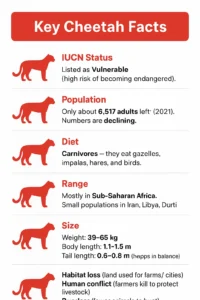- Are Cheetahs Friendly To Humans – Truth About Their Behavior
- Introduction:
- Human–Cheetah Interaction in History (Timeline)
Are Cheetahs Friendly To Humans – Truth About Their Behavior
Answer to the question Are cheetahs friendly? Cheetahs are not a threat to people. They are shy and tend to avoid getting close to the humans. As solitary animals they stay away from potential danger including larger predators and humans. They had only focused on finding food and protecting their young ones.
Cheetahs are not naturally dangerous to humans. They only act aggressively if they feel scared or trapped. When watching cheetahs in the wild it is best to do a safe distance from it especially on guided tours with experts. These guides understand cheetah behavior and make sure both people and animals stay safe. Even cheetahs are not usually aggressive but remember that they are strong wild animals.

Getting too close to cheetahs without understanding them can be dangerous for both people and the animals. We can help people and animals by supporting wildlife protection and conservation efforts.
Introduction:
Are cheetahs friendly to humans, or are they dangerous like lions and tigers? Many wildlife lovers and students ask this question. Thus, cheetahs may look similar to other big cats but their behavior is very different. While the lions, leopards and tigers are usually angry mammals but cheetahs are sometimes called the “gentle cats” of the wild life. In this article, we will see if cheetahs are dangerous, how they behave with humans and how they compare to the other big cats.
Cheetahs vs Other Big Cats
When people think about big cats then they usually think of danger. But not all cats act as the same way that others do. Let’s compare them:
- Lions & Tigers: These both are very strong and dangerous animals. They are territorial predators and protect their land and families from enemies. Their attacks on humans are not rare, especially if someone enters in their area.
- Leopards: Leopards are sneaky and powerful mammals. They sometimes come close to the area f villages and can attack the livestock or even people.
- Cheetahs: Cheetahs are different from lion and tigers. They are shy and not angry animal. They usually avoid humans and do not see people as their prey. If they feel scared, then they prefer to run away instead of fighting or killing humans.
Because of this cheetahs are considered as the least dangerous big cats for humans. In some African wildlife parks, under the careful supervision people can even interact with or walk beside tame cheetahs, this is something you could never do with lions or tigers.
Understanding Cheetahs Behaviour Towards Humans:
Cheetahs’ conduct toward humans is frequently misconstrued due to their image as vicious predators. It is critical to recognize that cheetahs are not naturally hostile to people. They are instead shy and evasive, avoiding direct contact with others whenever possible. Cheetahs, being solitary species, often avoid possible clashes with larger predators, including humans.
Their principal concern is survival hunting and safeguarding the safety of their cubs. Why are cheetahs friendly to humans? Cheetahs’ aggressiveness toward people is uncommon and mainly occurs when they are threatened or cornered. Even in such situations, their tendency is to escape rather than attack. It is critical to approach cheetahs in the wild with caution to safeguard your safety. Wildlife experiences, such as guided safari trips led by qualified specialists, provide a rare opportunity to watch cheetahs without interrupting their normal activity.
We may actively assist conservation initiatives aimed at maintaining their habitats and encouraging harmonious cohabitation with humans by increasing awareness and empathy for these amazing species. Responsible practices and educational programs are critical in protecting cheetahs’ well-being and ensuring their appropriate position in the natural environment.
Human–Cheetah Interaction in History (Timeline)
- Ancient Egypt (around 1500 BC): Cheetahs were kept as a pets and shown in art in shows. The most interesting thing of their history is that Pharaohs used them as symbols of royalty.
- Persia & Arabia: The kings and nobles of Persia and Arabia trained cheetahs as their hunting companions. They used them to chase the gazelles and other fast animals.
- India (Mughal Era): The historical emperors like Akbar the Great kept the hundreds of cheetahs for royal hunts. These animals were then highly prized in the market.
- Decline: Since cheetahs rarely bred in cage, people kept capturing them from the wild. Over time, this activity has introduced a decrease in their numbers in Asia and especially in India.
- Today: Instead of hunting them cheetahs are now protected in the reserves and studied for conservation.
Habitat & Sociability Of Cheetahs:
They are interesting animals with distinct qualities in terms of habitat and friendliness. These majestic large cats may be found across Africa, particularly in savannas, grasslands, and semi-deserts. Their habitat choice is largely related to the availability of broad expanses that allow them to attain their incredible speeds during hunts. Cheetahs, unlike many other large cats, are relatively friendly creatures. While they are mostly solitary species, they do form small, stable groups on occasion.
Female cheetahs typically have a loose bond with their offspring, allowing them to stay together for a lengthy amount of time. During the critical early stages of the cubs’ existence, this transitory social organization provides care and safety.
In contrast, male cheetahs often form coalitions, primarily comprising siblings from the same litter. These alliances enable them to establish territories and gain advantages when it comes to mating and protecting their territory from other predators. However, despite their sociable tendencies, cheetahs do not form the same tightly knit family units as some other big cat species.
They often prefer to roam and hunt independently to avoid competition for resources. Cheetahs are animals that have adapted to certain environments such as savannas and grasslands. Although they display a certain level of sociability, they remain primarily solitary animals, forming temporary associations with family members or forming male coalitions to establish territories. Understanding their habitat and sociability helps us appreciate their exceptional adaptability and behavior in the wild.
Efficient Hunting Skills & Methods Of Cheetahs:
The hunting abilities and strategies of cheetahs are extremely extraordinary, ranking it among the most effective predators in the animal kingdom. Cheetahs use their long, muscular tails as rudders during a pursuit, effectively maneuvering to keep their prey in sight while gracefully altering course. When they latch on to a target, their lightning-fast acceleration kicks in, allowing them to achieve speeds of up to 70 miles per hour in brief bursts while traversing huge distances in record time.
When closing in on their quarry, cheetahs utilize a distinct hunting technique known as the “trip and suffocate” method. In the final moments of the chase, they expertly swipe at their prey’s legs, causing it to stumble and fall, allowing the cheetah to quickly move in for the kill. Their powerful jaws and sharp teeth are then employed to swiftly suffocate their catch, incapacitating it effectively. Despite their remarkable skills, cheetahs have limited stamina and can only sustain their top speed for short distances.
Consequently, they strategically stalk their prey, conserving energy before initiating the explosive burst of speed needed for the final pursuit. Finally, cheetahs’ hunting abilities are astounding, depending on their remarkable speed, agility, and accuracy to capture their prey. Their distinct skills and adaptations underline their rank as one of the animal kingdom’s most skilled predators. Another question related is Do owls attack humans at night? visit the post if you want to know about it.

Are Cheetahs Dangerous to Humans? Reality Check
Research shows that the attack of wild cheetah on humans is almost zero. They usually run away instead of fighting with them. In cage, a few rare incidents had happened but no human deaths have been confirmed in these incidents. But if we compared to lions or tigers then cheetahs are the least dangerous big cats.
Conservation & Threats
Cheetahs are listed as the Vulnerable (IUCN). Their numbers are going down day by day because of:
- Habitat loss
- Prey shortage
- Human conflict
- Illegal wildlife trade
Today, only about 6,500 mature cheetahs remain in the wild life. Conservation groups are working on them to protect their habitat and stop illegal trade.
FunFacts About Cheetah:
Cheetahs are beautiful and attractive huge cats and possess a number of unique and distinguishing qualities that set them apart from the rest of the animal kingdom. Here are some fascinating cheetah facts:

1. Lightning Fast:
The cheetah is the world’s fastest land mammal that is capable of reaching speeds of up to 70 miles per hour in a matter of seconds. They have the acceleration of a high-performance sports vehicle!
2. Acceleration Masters:
In just three seconds, a cheetah can go from 0 to 60 miles per hour, outpacing most sports cars and leaving other predators far behind.
3. Non-Retractable Claws:
Unlike other big cats, cheetahs’ claws are semi-retractable, providing better traction during high-speed chases and acting like cleats for running.
4. Daytime Hunters:
Cheetahs are terrestrial hunters, which means they hunt during the day. Their excellent vision helps them to locate prey from afar.
5. Shy and Solitary:
While not naturally aggressive towards humans, cheetahs tend to be shy and elusive, often avoiding direct contact. They are primarily solitary animals, except during mating and cub-rearing periods.
6. Unique Hunting Technique:
Cheetahs employ a “trip and suffocate” method to take down their prey. They use their speed to chase and trip the target, then quickly suffocate it with a bite to the throat.
7. Sociable Siblings:
Male cheetahs often form coalitions with their siblings, cooperating to establish territories and improve their chances of survival.
8. Cub Camouflage:
Cheetah cubs have a distinctive silvery mantle of fur on their backs, acting as camouflage to blend in with tall grass and avoid detection by predators.
9. Acceleration Takes a Toll:
The high-speed chases during hunts demand immense energy, and cheetahs need extended periods of rest to recover after each pursuit.
10. Unique Vocalizations:
Cheetahs emit a variety of vocalizations, such as chirping noises, growls, and purrs, which play an important part in their communication with one another.
Behaviors Of Cheetahs To Other Animals:
Cheetahs exhibit distinct behaviors when interacting with other animals, revealing intriguing aspects of their social dynamics and survival strategies.
1. Solitary Predators:
Cheetahs are primarily solitary animals, preferring to hunt and roam alone. Unlike other big cats that form prides or groups, cheetahs often rely on their individual prowess for survival.
2. Avoiding Conflict:
To minimize potential conflicts with larger predators like lions and hyenas, cheetahs tend to avoid areas with high predator densities. They prefer open landscapes where they can spot danger from afar and escape quickly.
3. Vulnerable Cubs:
Female cheetahs, however, show unique social behavior when raising cubs. They often form temporary associations with their offspring, providing protection and guidance during the cubs’ early stages of life.
4. Interspecies Interactions:
Occasionally, cheetahs form coalitions, particularly among male siblings. These alliances help them secure and defend territories, increasing their chances of successful mating and survival.
5. Stalking Techniques:
When stalking prey, cheetahs rely on stealth and camouflage to get as close as possible before initiating a high-speed chase. Their approach is calculated, minimizing the risk of failure and injury during the hunt.
6. Non-Aggressive Towards Humans:
They are not known to be violent toward people and would usually avoid confrontations if given the opportunity to run. Wild animals should still be approached with caution to guarantee their safety and well-being.
7. Playful Nature:
Cheetahs, especially cubs, display a playful demeanor, engaging in mock hunting and wrestling games with their siblings, enhancing their hunting skills and strengthening social bonds.
8. Vocalizations:
Cheetahs communicate with a range of vocalizations, including chirping sounds, purrs, and growls, used for territorial marking, attracting mates, and coordinating with cubs.
Overall, the behaviors of cheetahs towards other animals demonstrate their adaptability and survival strategies in their dynamic natural habitats. From solitary hunting prowess to temporary social interactions, these behaviors highlight the remarkable flexibility and complexity of these majestic big cats.
Facts & Features Of Cheetahs:
- They can reach speeds of about 70 miles per hour in short bursts by making them the world’s fastest terrestrial mammals.
- Cheetahs are not only fast but they also move swiftly.
- They can accelerate from zero to sixty miles per hour in seconds by exceeding even the most powerful vehicles.
- Cheetahs’ fur is adorned with beautiful black spots on a golden-yellow coat, providing them with excellent camouflage in their natural grassland habitats.
- Distinctive black tear marks under their eyes help reduce glare from the sun while they hunt, enhancing their visual focus during chases.
- Unlike other big cats, cheetahs possess semi-retractable claws that provide crucial traction during high-speed pursuits.
- Cheetahs are primarily daytime hunters, relying on their keen eyesight to spot potential prey from afar.
- Although they may form temporary coalitions with siblings or mates, cheetahs are primarily solitary animals, emphasizing their self-reliance during hunts.
- Cheetah cubs are known for their adorable playfulness, engaging in games that hone their hunting skills and strengthen social bonds.
- Cheetah facts and characteristics emphasize their amazing adaptations and activities, making them an animal kingdom sign of agility and elegance.
- Understanding and appreciating these unique qualities contribute to the efforts to protect and preserve these magnificent creatures for future generations.
Do You Know About:
FAQs:
1 Are cheetahs friendly with humans?
Cheetahs are generally not aggressive towards humans and are known for their shy and elusive nature. However, they are wild animals, and interactions should be approached with caution and respect for their natural instincts.
2 Can you pet a cheetah?
Petting a cheetah is not recommended as they are wild animals and can be unpredictable. Interacting with cheetahs should be limited to observing them from a safe distance in their natural habitat.
3 Is A cheetah aggressive?
Cheetahs are not inherently aggressive towards humans or other animals. They are generally shy and elusive, preferring to avoid conflicts whenever possible.
4 Do cheetahs see humans as prey?
No, cheetahs do not see humans as prey. They are not known for attacking humans unprovoked and tend to avoid human contact whenever possible.
5 Do cheetahs attack humans?
Cheetahs are not known for attacking humans. They are generally shy and elusive, and instances of cheetahs showing aggression towards humans are rare and typically occur when the cheetah feels threatened or cornered.
